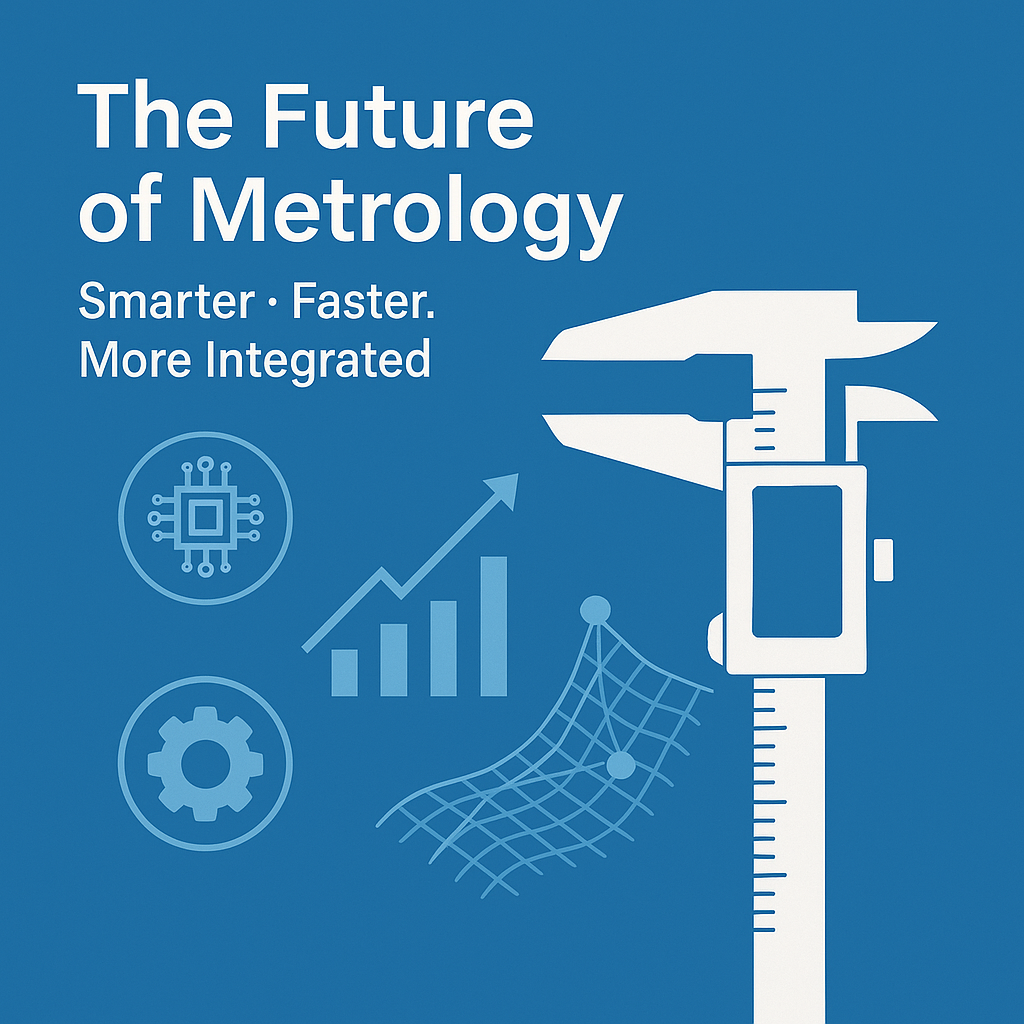The Future of Metrology: From Precision to Prediction
By Mark Boucher
In the not-so-distant past, metrology was often seen as a quiet science operating behind the scenes, simply confirming that products met the required standards. However, the future of metrology is rapidly changing. Instead of merely verifying quality, metrology is now poised to become an active, predictive force that drives continuous improvements throughout the manufacturing process. Today’s advancements in metrology are moving beyond simple measurement to become integral tools for smarter manufacturing systems.
Technological advancements like AI and machine learning, edge computing, and cloud-integrated CMMs (Coordinate Measuring Machines) are enabling a shift from traditional, post-production measurement to real-time, in-process feedback. This shift means that manufacturing systems are no longer reactive—they can actively learn and adapt based on data collected during production. In this new era of metrology, measurement tools not only confirm quality but also provide insights that help prevent defects before they happen, thus enabling manufacturers to operate more efficiently and with greater precision.
One of the most exciting developments in this transformation is the rise of autonomous metrology systems. Tools like Hexagon’s Autonomous Metrology Suite and Renishaw’s Equator with AI integration are beginning to make real-time, autonomous adjustments to measurement systems. In this future, a CMM could automatically schedule its own calibration, adapt to changes in environmental conditions like temperature drift, and even conduct inspections simultaneously with production. This level of automation in metrology has the potential to drastically reduce human error and increase efficiency on the shop floor.
The concept of digital twins is another significant trend that’s changing the way we approach metrology. Digital twins are virtual models of physical objects that use real-world data to update and refine simulations. By integrating metrology data into these models, manufacturers can create closed-loop systems where every physical measurement feeds directly into the virtual model, allowing manufacturers to anticipate design flaws, optimize production processes, and simulate quality improvements before they’re ever made. This creates a powerful synergy between the digital and physical worlds, ensuring that design intent is maintained and quality decisions are made with full context.
Perhaps most notably, metrology is evolving from a necessary but secondary task into a key competitive advantage for manufacturers. Companies are increasingly seeing value in using metrology not just for compliance or quality control, but as a strategic tool to drive down costs, improve first-pass yield, reduce scrap, and shorten time-to-market. In today’s competitive landscape, leveraging metrology data is becoming one of the most effective ways to gain a competitive edge and meet the growing demands of quality-conscious customers.
Looking to the future, there are several key trends to watch in metrology. Inline X-ray CT scanning and non-contact probing will become more common, enabling manufacturers to inspect complex geometries that were previously difficult or impossible to measure. Metrology-as-a-Service platforms will make high-end measurement tools more accessible to smaller manufacturers, while advancements in interoperable standards will enable more seamless integration of data across different metrology systems. Finally, as automation increases, we will likely see more collaboration between humans and machines, with AI assistants helping to streamline measurement planning and execution.
As we look to the next five years, the evolution of metrology promises to deliver even more innovation and efficiency to the manufacturing sector. We’re entering a time when measurement tools will no longer just confirm quality—they will actively contribute to improving it, helping manufacturers stay ahead in an increasingly competitive world.
Featured Case Study 1: Senior Aerospace Weston
Transforming Aerospace Inspection with Flexible Gauging
Senior Aerospace Weston, a leading manufacturer of aerostructure components, faced growing pressure to improve inspection efficiency without compromising precision. Traditional manual inspection methods were slowing production and lacked the flexibility needed for their high-mix manufacturing environment.
To solve this, the company implemented the Renishaw Equator™ gauging system—a programmable, flexible solution designed to replace hard gauges and manual tools. The Equator allowed operators to quickly switch between part programs and perform comparative inspections with high repeatability and traceability.
As a result, Senior Aerospace Weston reduced inspection time per part by approximately 75%. They also achieved more consistent results across multiple shifts, improved traceability, and gained the flexibility needed to adapt inspection routines quickly to changing production requirements.
Read more: Senior Aerospace Weston Case Study – Renishaw
Featured Case Study 2: SiO₂ + Verus Metrology Partners
Accelerating COVID-19 Kit Production with Automated Gauging
During the COVID-19 pandemic, SiO₂ Medical Products needed to dramatically increase the throughput of their vial and cap inspection processes to meet unprecedented demand. Manual checks weren’t scalable, and traditional systems couldn’t keep up with the production volume required.
SiO₂ partnered with Verus Metrology Partners to implement a high-speed inspection solution using the Renishaw Equator 300 gauging system in combination with custom-engineered 8-station fixtures. This allowed for simultaneous inspection of multiple plastic components in each cycle, all while maintaining high measurement accuracy and full data traceability.
The integration significantly reduced inspection cycle times, improved quality consistency, and enabled round-the-clock operation with minimal operator input. This solution helped SiO₂ scale production to meet critical timelines for COVID-19 test kits without compromising quality.
Read more: SiO₂ Case Study – Verus Metrology

